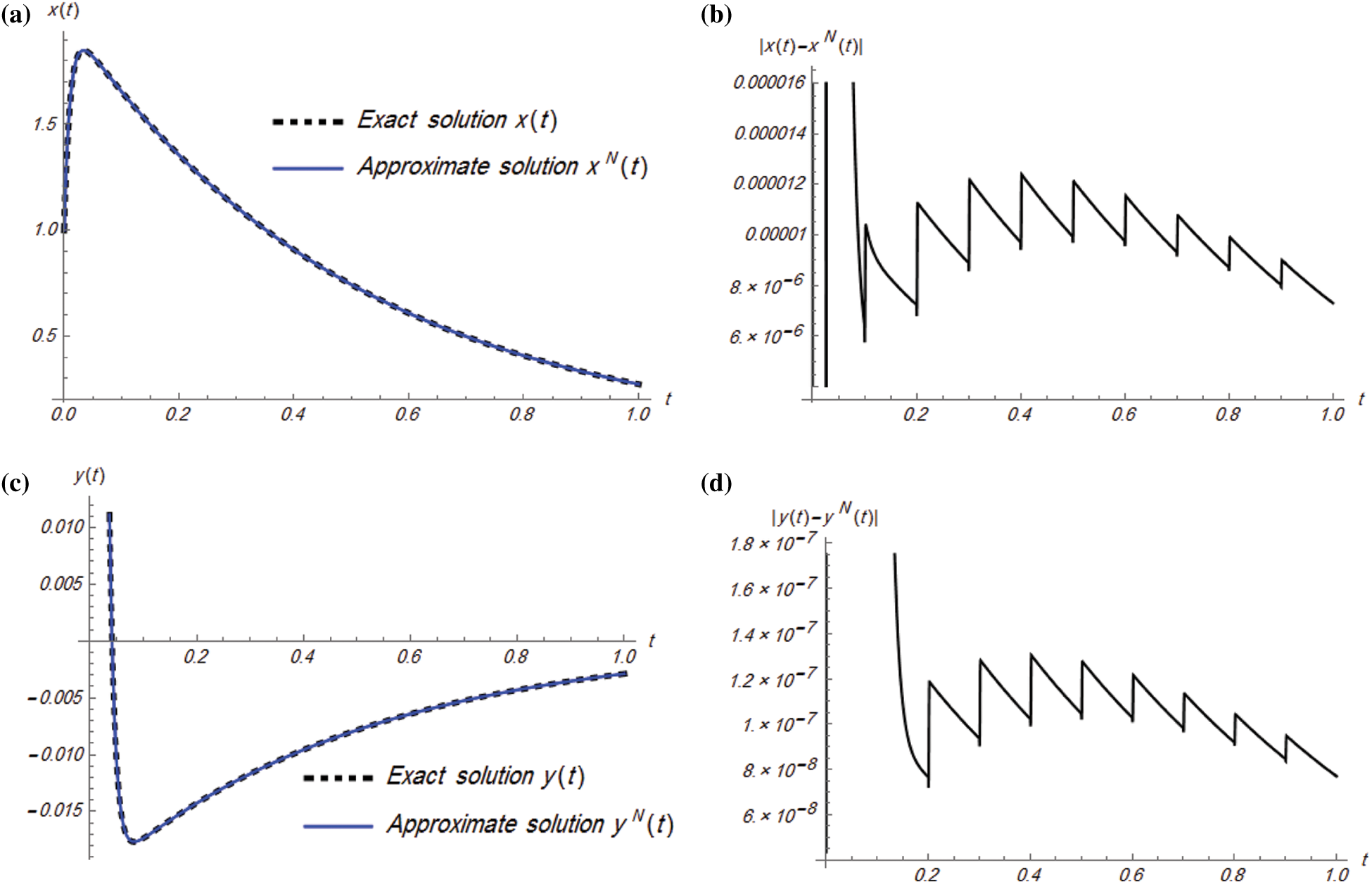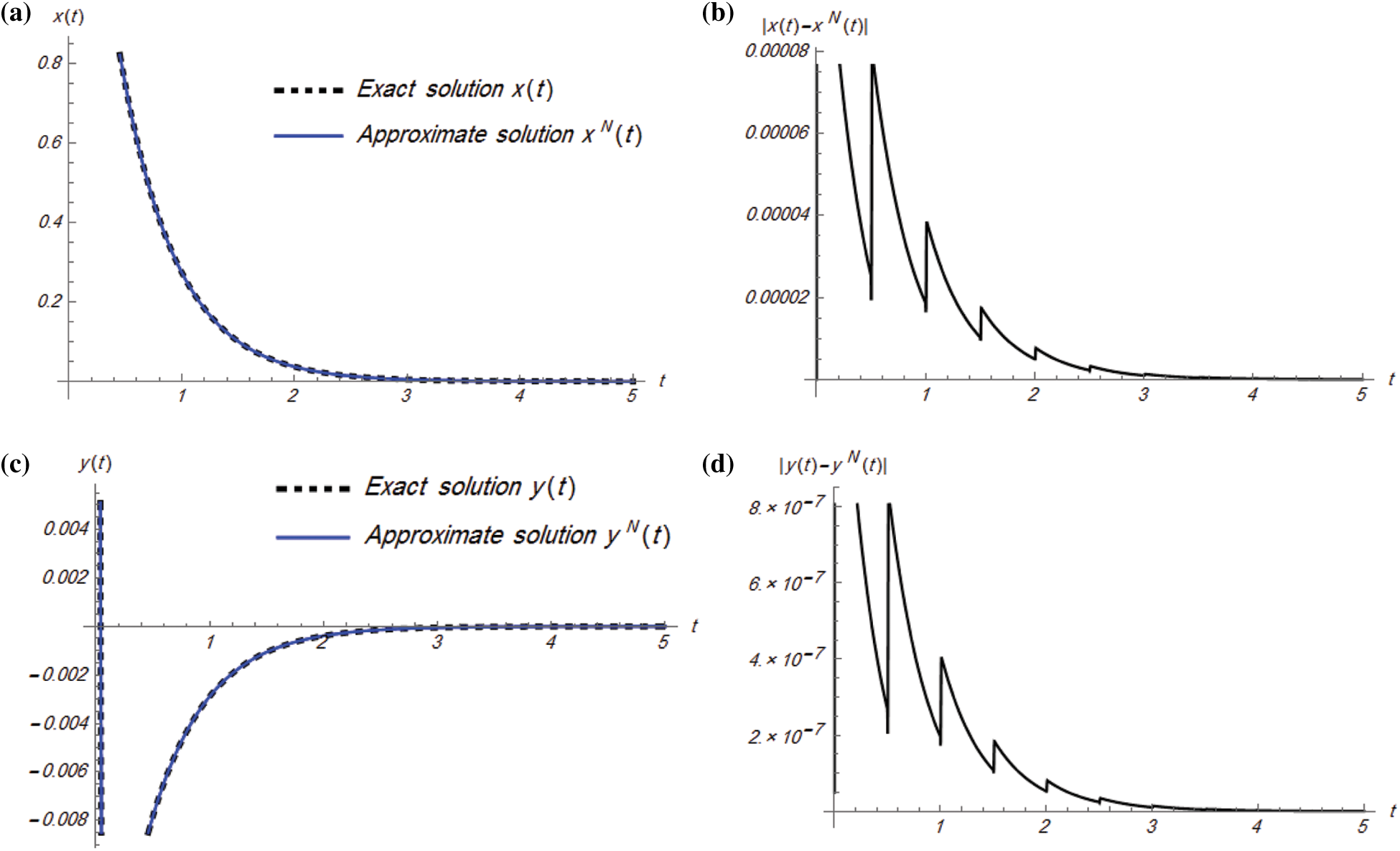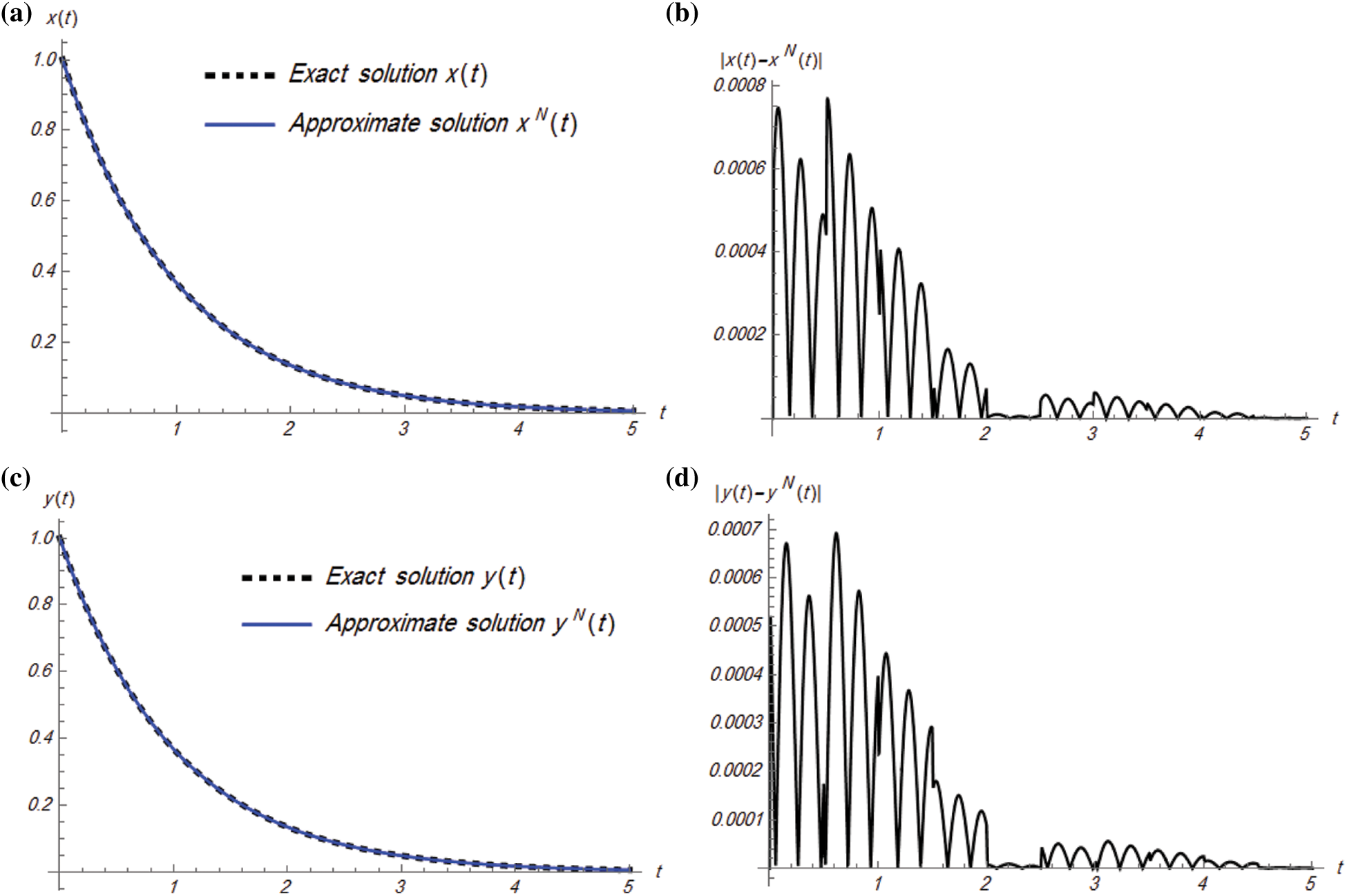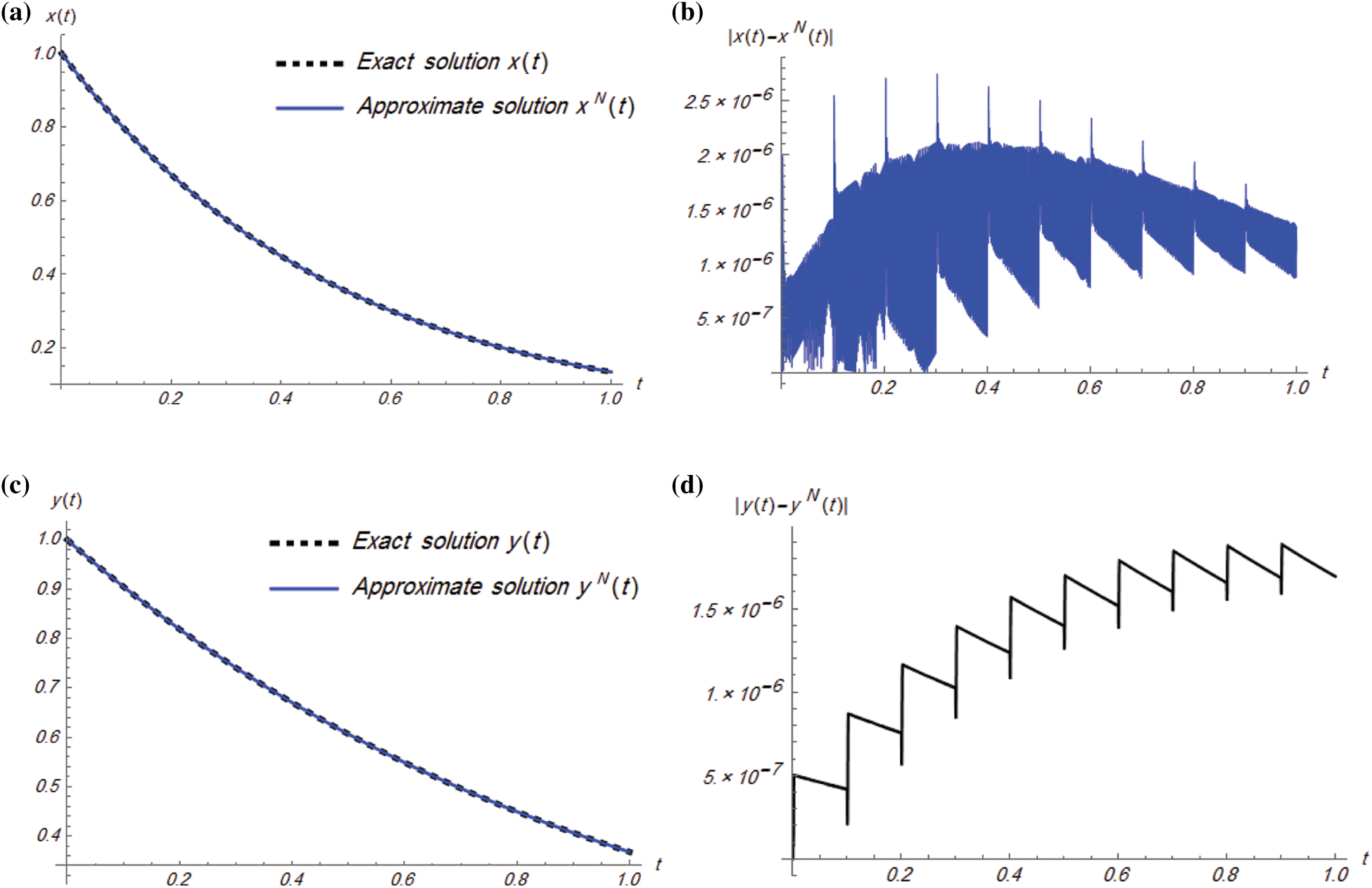

 | Computer Modeling in Engineering & Sciences |  |
DOI: 10.32604/cmes.2022.017010
ARTICLE
Attractive Multistep Reproducing Kernel Approach for Solving Stiffness Differential Systems of Ordinary Differential Equations and Some Error Analysis
1Department of Mathematics, Faculty of Science, Zarqa University, Zarqa, 13132, Jordan
2Department of Applied Science, Ajloun College, Al-Balqa Applied University, Ajloun, 26816, Jordan
3Department of Physics and Basic Sciences, Faculty of Engineering Technology, Al-Balqa Applied University, Amman, 11134, Jordan
4Nonlinear Dynamics Research Center (NDRC), Ajman University, Ajman, 20550, United Arab Emirates
5Department of Mathematics, Faculty of Science, The University of Jordan, Amman, 11942, Jordan
*Corresponding Author: Shrideh Al-Omari. Email: shridehalomari@bau.edu.jo
Received: 19 April 2021; Accepted: 27 July 2021
Abstract: In this paper, an efficient multi-step scheme is presented based on reproducing kernel Hilbert space (RKHS) theory for solving ordinary stiff differential systems. The solution methodology depends on reproducing kernel functions to obtain analytic solutions in a uniform form for a rapidly convergent series in the posed Sobolev space. Using the Gram-Schmidt orthogonality process, complete orthogonal essential functions are obtained in a compact field to encompass Fourier series expansion with the help of kernel properties reproduction. Consequently, by applying the standard RKHS method to each subinterval, approximate solutions that converge uniformly to the exact solutions are obtained. For this purpose, several numerical examples are tested to show proposed algorithm’s superiority, simplicity, and efficiency. The gained results indicate that the multi-step RKHS method is suitable for solving linear and nonlinear stiffness systems over an extensive duration and giving highly accurate outcomes.
Keywords: Multi-step approach; reproducing kernel Hilbert space method; stiffness system; error analysis; numerical solution
During studying and modeling many basic physical phenomena, such as chemical kinematics, aerodynamics, electrical circuits, ballistics, control models, and missile guidance, a type of differential equations appears that is difficult to solve through traditional numerical procedures, called differential stiffness system, which was first highlighted in the work of Curtiss and Hirschfelder [1–6]. Mathematical stiffness models reflect the different growth rates and various dynamic processes of the considered physical systems. It arises when some of the solution components decay much more rapidly than other components because they contain the term
subject to the initial conditions
By classical RKHS method to solve this system with 100 nodes, the numerical results will be achieved under the rapid increase of the error as shown in Fig. 1. Simultaneously, increasing the number of nodes leads to the need for large computer memory along with long operating times, and cumulative errors may also affect the accuracy of the solutions. However, to overcome such drawbacks, an advanced numerical algorithm will be formulated based on dividing any temporal interval into small subintervals and then applying the standard RKHS method on each subinterval. This technique is called a multi-step reproducing Hilbert space (MS-RKHS) method. It is worth noting here that there are advanced methods in the literature to address many different engineering and physical problems, for more detail we refer to [25–30] and references therein.

Figure 1: (a) Exact (--) and classic RKHS approximate (
By and large, there are no conventional analytical or semi-approximate methods that produce precise approximate or closed-form solutions for stiff differential systems. Therefore, there has become an urgent need for effective numerical algorithms to find accurate solutions for such models especially for large periods of time. This gives us the incentive, in this work, to explore effective accurate solutions [31–39]. Motivated by the previous discussion, our study aims to design a novel iterative algorithm to generate an analytical solution to stiff models of ordinary differential equations over a large duration through the use of a multi-step technique. To begin with, two reproducing kernel functions are established to generate a complete orthonormal basis in the Hilbert space. Based on reproducing kernel property, linear, bounded, and invertible differential operator is defined to create an analytical solution of the proposed model over a dense partition of the time period. In this direction, the approximate solution converges uniformly to the analytical solution. Error analysis is discussed as well. Lastly, some numerical examples are presented to illustrate the reliability and efficiency of the suggested multi-step approach. This paper is organized in five sections including the introduction. In Section 2, a brief description of the RKHS method is given. In Section 3, the MS-RKHS method is presented. In Section 4, several examples are given. Finally, a short conclusion is presented in Section 5.
2 Reproducing Kernel Hilbert Space Method
A reproducing kernel space is a Hilbert space
1.
2.
where K is the reproducing kernel function of
The reproducing kernel function possesses many nice properties, including it being unique, positive definite, conjugate symmetric. For the theory and applications of RKHS, we refer to [40–45].
Definition 2.1 [46]: The function space
The inner product for
Theorem 1.1 [46]: The space
Definition 2.2 [47]: The function space
with inner product for
Theorem 2.2 [47]: The space
Hereinafter, we consider the following stiff system:
along with the following initial conditions (ICs)
To solve system (3)–(4) using the RKHS method, we first homogenize ICs (4) in light of the following transformation:
which leads to the following system:
Subsequently, we define the differential operator
Herein, we have to construct an orthogonal function system of the space
Next, we will use the Gram-Schmidt orthogonalization process on
Let
The following theorems give the form of the solution of system (6).
Theorem 2.3: If
The N-term approximate solution
Eventually, the solution of system (3) is obtained as
3 Multi-Step Reproducing Kernel Hilbert Space Method
To clarify the MS-RKHS method that used in this work to find approximate solutions of system (3), we divide the interval
to get the approximate solution:
Second, we apply the standard RKHS method again to the problem:
to get the approximate solution:
Continuing this process at each subinterval and applying the standard RKHS method to the problems:
to get the approximate solutions:
So, the solution of system (3) using the MS-RKHS method is given by
In this section, we will apply the MS-RKHS method described in Section 3 to solve some linear and nonlinear examples of stiff systems. In each example, we compare the exact solution with the approximate one when N = 100. The results are given in tables and graphs. Computations will be performed via Mathematica 10.0 software package.
Example 4.1: Consider the following homogeneous linear stiff system:
subject to the initial conditions
The exact solution of system (12) is



Figure 2: Plots of exact and approximate solutions and absolute error of Example 4.1 for

Figure 3: Plots of exact and approximate solutions and absolute error of Example 4.1 for
Example 4.2: Consider the following nonhomogeneous linear stiff system:
subject to the initial conditions
The exact solution of system (13) is


Example 4.3: Consider the following nonlinear stiff system:
subject to the initial conditions
The exact solution of system (14) is

Figure 4: Plots of exact and approximate solutions and absolute error of Example 4.2 for


Figure 5: Plots of exact and approximate solutions and absolute error of Example 4.3 for
Example 4.4: Consider the following stiff system:
subject to the initial conditions
The exact solution of system (15) is given as
In the following, some numerical and graphical simulation of Example 4.4 are performed in Table 6 and Fig. 6 for


Figure 6: Plots of the exact and approximate solutions of Example 4.4 for
In this work, a modified multi-step algorithm, the MS-RKHS method, has been lucratively implemented based on the standard RKHS method to obtain approximate solutions of stiff systems of ordinary differential equations. Several examples of linear and non-linear stiff systems have been given to show the efficiency of the proposed method. The achieved results have been presented numerically and graphically as well. By comparing our results with the exact solutions and classical RKHS method, we observe that the MS-RKHS method yields accurate approximations. Moreover, using the MS-RKHS method, the intervals of convergence for the series solution will increase without needing large computer memory, which takes less time to give accurate numerical results. For the near future work, the presented multi-step approach will be applied for solving stiff systems of fractional and partial differential equations along with nonclassical conditions.
Acknowledgement: Authors would like to thank reviewers for their insightful comments and suggestions. The first author is grateful for the support provided by Zarqa University, Jordan.
Funding Statement: The authors received no specific funding for this study.
Conflicts of Interest: The authors declare that they have no conflicts of interest to report regarding the present study.
1. Shalashilin, V., Kuznetsov, E. (2003). Parametric continuation and optimal parametrization in applied mathematics and mechanics. Dordrech: Springer Science & Business Media. DOI 10.1007/978-94-017-2537-8. [Google Scholar] [CrossRef]
2. Curtiss, C., Hirschfelder, J. (1952). Integration of stiff equations. Proceedings of the National Academy of Sciences of the United States of America, 38(3), 235. DOI 10.1073/pnas.38.3.235. [Google Scholar] [CrossRef]
3. Aminikhah, H., Hemmatnezhad, M. (2011). An effective modification of the homotopy perturbation method for stiff systems of ordinary differential equations. Applied Mathematics Letters, 24(9), 1502–1508. DOI 10.1016/j.aml.2011.03.032. [Google Scholar] [CrossRef]
4. Akinfenwa, O., Akinnukawe, B., Mudasiru, S. (2015). A family of continuous third derivative block methods for solving stiff systems of first ordinary differential equations. Journal of Nigerian Mathematical Society, 34(2), 160–168. DOI 10.1016/j.jnnms.2015.06.002. [Google Scholar] [CrossRef]
5. Yakubu, D., Markus, S. (2016). The efficiency of second derivative multistep methods for the numerical integration of stiff systems. Journal of Nigerian Mathematical Society, 35(1), 107–127. DOI 10.1016/j.jnnms.2016.02.002. [Google Scholar] [CrossRef]
6. Atay, M., Kilic, O. (2013). The semianalytical solutions for stiff systems of ordinary differential equations by using variational iteration method and modified variational iteration method with comparison to exact solutions. Mathematical Problems in Engineering, 2013(1--2), 143915. DOI 10.1155/2013/143915. [Google Scholar] [CrossRef]
7. Al-Smadi, M., Freihat, A., Khalil, H., Momani, S., Khan, R. A. (2017). Numerical multistep approach for solving fractional partial differential equations. International Journal of Computational Methods, 14(3), 1750029. DOI 10.1142/S0219876217500293. [Google Scholar] [CrossRef]
8. Al-Smadi, M., Abu Arqub, O., Momani, S. (2020). Numerical computations of coupled fractional resonant Schrödinger equations arising in quantum mechanics under conformable fractional derivative sense. Physica Scripta, 95(7), 75218. DOI 10.1088/1402-4896/ab96e0. [Google Scholar] [CrossRef]
9. Yang, X. J. (2019). New non-conventional methods for quantitative concepts of anomalous rheology. Thermal Science, 23(6B), 427. DOI 10.2298/TSCI191028427Y. [Google Scholar] [CrossRef]
10. Momani, S., Abu Arqub, O., Freihat, A., Al-Smadi, M. (2016). Analytical approximations for Fokker-Planck equations of fractional order in multistep schemes. Applied and Computational Mathematics, 15(3), 319–330. [Google Scholar]
11. Komashynska, I., Al-Smadi, M., Ateiwi, A., Al-Obaidy, S. (2016). Approximate analytical solution by residual power series method for system of Fredholm integral equations. Applied Mathematics and Information Sciences, 10(3), 975–985. DOI 10.18576/amis/100315. [Google Scholar] [CrossRef]
12. Al-Smadi, M. H., Gumah, G. N. (2014). On the homotopy analysis method for fractional SEIR epidemic model. Research Journal of Applied Sciences, Engineering and Technology, 7(18), 3809–3820. DOI 10.19026/rjaset.7.738. [Google Scholar] [CrossRef]
13. Momani, S., Freihat, A., Al-Smadi, M. (2014). Analytical study of fractional-order multiple chaotic FitzHugh-Nagumo neurons model using multistep generalized differential transform method. Abstract and Applied Analysis, 2014(4), 276279. DOI 10.1155/2014/276279. [Google Scholar] [CrossRef]
14. Shqair, M., Al-Smadi, M., Momani, S., El-Zahar, E. (2020). Adaptation of conformable residual power series scheme in solving nonlinear fractional quantum mechanics problems. Applied Sciences, 10(3), 890. DOI 10.3390/app10030890. [Google Scholar] [CrossRef]
15. Jafari, H., Tajadodi, H., Kadkhoda, N., Baleanu, D. (2013). Fractional sub equation method for Cahn-Hilliard and Klein-Gordon equations. Abstract and Applied Analysis, 2013(1), 587179. DOI 10.1155/2013/587179. [Google Scholar] [CrossRef]
16. Abdeljawad, T., Ullah, K., Ahmad, J., de la Sen, M., Khan, M. N. (2021). Some convergence results for a class of generalized nonexpansive mappings in Banach spaces. Advances in Mathematical Physics, 2021, 1–6. DOI 10.1155/2021/8837317. [Google Scholar] [CrossRef]
17. Abdeljawad, T. (2019). Fractional difference operators with discrete generalized Mittag-Leffler kernels. Chaos, Solitons and Fractals, 126(2), 315–324. DOI 10.1016/j.chaos.2019.06.012. [Google Scholar] [CrossRef]
18. Al-Smadi, M., Abu Arqub, O., Momani, S. (2013). A computational method for two-point boundary value problems of fourth-order mixed integrodifferential equations. Mathematical Problems in Engineering, 2013(4), 832074. DOI 10.1155/2013/832074. [Google Scholar] [CrossRef]
19. Al-Smadi, M., Abu Arqub, O., Shawagfeh, N., Momani, S. (2016). Numerical investigations for systems of second-order periodic boundary value problems using reproducing kernel method. Applied Mathematics and Computation, 291(9), 137–148. DOI 10.1016/j.amc.2016.06.002. [Google Scholar] [CrossRef]
20. Harrouche, N., Momani, S., Hasan, S., Al-Smadi, M. (2021). Computational algorithm for solving drug pharmacokinetic model under uncertainty with nonsingular kernel type Caputo-Fabrizio fractional derivative. Alexandria Engineering Journal, 60(5), 4347–4362. DOI 10.1016/j.aej.2021.03.016. [Google Scholar] [CrossRef]
21. Hasan, S., Al-Smadi, M., El-Ajou, A., Momani, S., Hadid, S. et al. (2021). Numerical approach in the Hilbert space to solve a fuzzy Atangana-Baleanu fractional hybrid system. Chaos, Solitons and Fractals, 143(7), 110506. DOI 10.1016/j.chaos.2020.110506. [Google Scholar] [CrossRef]
22. Al-Smadi, M. (2018). Simplified iterative reproducing kernel method for handling time-fractional BVPs with error estimation. Ain Shams Engineering Journal, 9(4), 2517–2525. DOI 10.1016/j.asej.2017.04.006. [Google Scholar] [CrossRef]
23. Djeddi, N., Hasan, S., Al-Smadi, M., Momani, S. (2020). Modified analytical approach for generalized quadratic and cubic logistic models with Caputo-Fabrizio fractional derivative. Alexandria Engineering Journal, 59(6), 5111–5122. DOI 10.1016/j.aej.2020.09.041. [Google Scholar] [CrossRef]
24. Al-Smadi, M. (2019). Reliable numerical algorithm for handling fuzzy integral equations of second kind in Hilbert spaces. Filomat, 33(2), 583–597. DOI 10.2298/FIL1902583A. [Google Scholar] [CrossRef]
25. Habenom, H., Suthar, D. L., Baleanu, D., Purohit, S. D. (2021). A numerical simulation on the effect of vaccination and treatments for the fractional hepatitis B model. ASME Journal of Computational and Nonlinear Dynamics, 16(1), 11004. DOI 10.1115/1.4048475. [Google Scholar] [CrossRef]
26. Agarwal, R., Yadav, M. P., Baleanu, D., Purohit, S. D. (2020). Existence and uniqueness of miscible flow equation through porous media with a nonsingular fractional derivative. AIMS Mathematics, 5(2), 1062–1073. DOI 10.3934/math.2020074. [Google Scholar] [CrossRef]
27. Al-Smadi, M., Djeddi, N., Momani, S., Al-Omari, S., Araci, S. (2021). An attractive numerical algorithm for solving nonlinear Caputo-Fabrizio fractional Abel differential equation in a Hilbert space. Advances in Difference Equations, 2021(1), 271. DOI 10.1186/s13662-021-03428-3. [Google Scholar] [CrossRef]
28. Kritika, Agarwal, R., Purohit, S. D. (2020). Mathematical model for anomalous subdiffusion using conformable operator. Chaos Solitons Fractals, 140(2), 110199. DOI 10.1016/j.chaos.2020.110199. [Google Scholar] [CrossRef]
29. Suthar, D. L., Purohit, S. D., Araci, S. (2020). Solution of fractional kinetic equations associated with the (p, q)-Mathieu-type series. Discrete Dynamics in Nature and Society, 2020(1), 8645161. DOI 10.1155/2020/8645161. [Google Scholar] [CrossRef]
30. Al-Smadi, M. (2021). Fractional residual series for conformable time-fractional Sawada-Kotera-Ito, Lax, and Kaup-Kupershmidt equations of seventh order. Mathematical Methods in the Applied Sciences (in Editing). DOI 10.1002/mma.7507. [Google Scholar] [CrossRef]
31. Alabedalhadi, M., Al-Smadi, M., Al-Omari, S., Baleanu, D., Momani, S. (2020). Structure of optical soliton solution for nonliear resonant space-time Schrödinger equation in conformable sense with full nonlinearity term. Physica Scripta, 95(10), 105215. DOI 10.1088/1402-4896/abb739. [Google Scholar] [CrossRef]
32. Kumar, S., Kumar, A., Samet, B., Dutta, H. (2021). A study on fractional host-parasitoid population dynamical model to describe insect species. Numerical Methods for Partial Differential Equations, 37(2), 1673–1692. DOI 10.1002/num.22603. [Google Scholar] [CrossRef]
33. Al-Smadi, M., Abu Arqub, O., Zeidan, D. (2021). Fuzzy fractional differential equations under the Mittag-Leffler kernel differential operator of the ABC approach: Theorems and applications. Chaos, Solitons and Fractals, 146(16), 110891. DOI 10.1016/j.chaos.2021.110891. [Google Scholar] [CrossRef]
34. Kumar, S., Kumar, R., Agarwal, R. P., Samet, B. (2020). A study of fractional Lotka-Volterra population model using Haar wavelet and Adams–Bashforth–Moulton methods. Mathematical Methods in the Applied Sciences, 43(8), 5564–5578. DOI 10.1002/mma.6297. [Google Scholar] [CrossRef]
35. Kumar, S., Kumar, R., Cattani, C., Samet, B. (2020). Chaotic behaviour of fractional predator-prey dynamical system. Chaos, Solitons and Fractals, 135(17), 109811. DOI 10.1016/j.chaos.2020.109811. [Google Scholar] [CrossRef]
36. Al-Smadi, M., Abu Arqub, O., Hadid, S. (2020). Approximate solutions of nonlinear fractional Kundu–Eckhaus and coupled fractional massive Thirring equations emerging in quantum field theory using conformable residual power series method. Physica Scripta, 95(10), 105205. DOI 10.1088/1402-4896/abb420. [Google Scholar] [CrossRef]
37. Al-Smadi, M., Abu Arqub, O., Hadid, S. (2020). An attractive analytical technique for coupled system of fractional partial differential equations in shallow water waves with conformable derivative. Communications in Theoretical Physics, 72(8), 85001. DOI 10.1088/1572-9494/ab8a29. [Google Scholar] [CrossRef]
38. Al-Smadi, M., Dutta, H., Hasan, S., Momani, S. (2021). On numerical approximation of Atangana-Baleanu-Caputo fractional integro-differential equations under uncertainty in Hilbert space. Mathematical Modelling of Natural Phenomena, 16, 41. DOI 10.1051/mmnp/2021030. [Google Scholar] [CrossRef]
39. Dutta, H., Akdemir, A., Atangana, A. (2020). Fractional order analysis: Theory, methods and applications. Hoboken, USA: John Wiley and Sons, Ltd. [Google Scholar]
40. Al-Smadi, M., Abu Arqub, O., El-Ajou, A. (2014). A numerical iterative method for solving systems of first-order periodic boundary value problems. Journal of Applied Mathematics, 2014(1), 135465. DOI 10.1155/2014/135465. [Google Scholar] [CrossRef]
41. Gumah, G., Moaddy, K., Al-Smadi, M., Hashim, I. (2016). Solutions to uncertain Volterra integral equations by fitted reproducing kernel Hilbert space method. Journal of Function Spaces, 2016(50), 2920463. DOI 10.1155/2016/2920463. [Google Scholar] [CrossRef]
42. Al-Smadi, M., Abu Arqub, O. (2019). Computational algorithm for solving fredholm time-fractional partial integrodifferential equations of dirichlet functions type with error estimates. Applied Mathematics and Computation, 342, 280–294. DOI 10.1016/j.amc.2018.09.020. [Google Scholar] [CrossRef]
43. Hasan, S., El-Ajou, A., Hadid, S., Al-Smadi, M., Momani, S. (2020). Atangana–Baleanu fractional framework of reproducing kernel technique in solving fractional population dynamics system. Chaos, Solitons and Fractals, 133(3), 109624. DOI 10.1016/j.chaos.2020.109624. [Google Scholar] [CrossRef]
44. Al-Smadi, M., Abu Arqub, O., Gaith, M. (2021). Numerical simulation of telegraph and Cattaneo fractional-type models using adaptive reproducing kernel framework. Mathematical Methods in the Applied Sciences, 44(10), 8472–8489. DOI 10.1002/mma.6998. [Google Scholar] [CrossRef]
45. Aronszajn, N. (1950). Theory of reproducing kernels. Transaction of the American Mathematical Society, 68(3), 337–404. DOI 10.1090/S0002-9947-1950-0051437-7. [Google Scholar] [CrossRef]
46. Cui, M., Lin, Y. (2009). Nonlinear numerical analysis in the reproducing kernel space. New York, NY, USA: Nova Science. [Google Scholar]
47. Li, C., Cui, M. (2003). The exact solution for solving a class nonlinear operator equations in the reproducing kernel space. Applied Mathematics and Computation, 143(2–3), 393–399. DOI 10.1016/S0096-3003(02)00370-3. [Google Scholar] [CrossRef]
 | This work is licensed under a Creative Commons Attribution 4.0 International License, which permits unrestricted use, distribution, and reproduction in any medium, provided the original work is properly cited. |